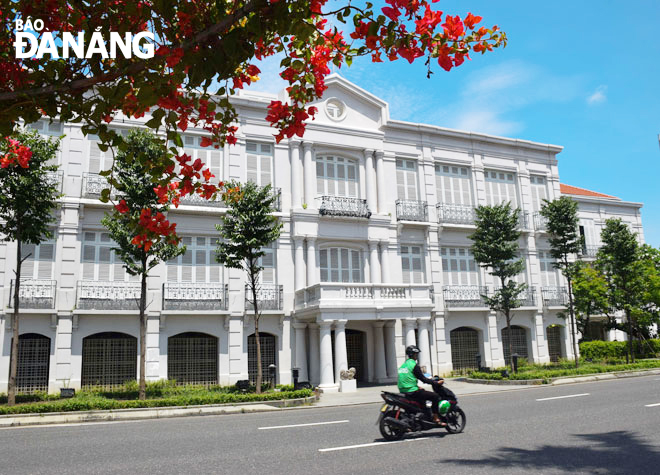Keep Da Nang soul during urban reconstruction
There are no buildings or temples that are intended for mere use. In addition to their beauty and urban life significance, they also contain the meaning of relationships between people when they have left their mark on space and time. Therefore, preserving cultural heritage in the process of urban reconstruction not only keep the ‘soul’ of the inner city but also preserves historical and cultural values for future generations.
 |
| Shell Cerde de Torance Company Building (now 44 Bach Dang) has French-style architecture after being restored and preserved. Photo: D.H.L |
Looking for ancient features in the inner city
In reality, cities around the world such as Jerusalem, Paris and Beijing attract tourists because people try to preserve every broken column, every mossy wall, every street corner which inherently makes up the identity of the city. It is the tangible and intangible cultural heritage of the city that creates the soul of that city.
Wandering on the spacious, clean and beautiful streets in the inner city of Da Nang, we glimpsed houses with ancient architecture among modern buildings that made us calm and nostalgic, thereby understand more about the formation and development process of urban areas along the banks of the romantic Han River.
Ms. Phan Thi Xuan Mai, Head of the Heritage Management Department of Da Nang Museum, said that, after 1945, Da Nang’s architectural assets gradually affected by fluctuations in climate, resistance war and natural disasters.
After 2000, some remaining works were deformed and destroyed due to the impact of urbanisation. Meanwhile, private owners of ancient houses do not have the expertise to preserve their properties. For example, they changed the yin-yang tiled house to a corrugated iron roof so 50% of the value of the old house was seemingly lost. These are pressing issues that require more effective coordination between the State and private individuals during conservation and preservation.
Currently, in Da Nang, there are 71 architectural works which have yet to be recognised, including about 22 French-style ones, a number of temples and traditional folk houses that have both architectural and historical values.
Valuable architectural works that are currently the headquarters of State agencies have been restored according to conservation principles. As for private ancient houses, their owners expand them according to their needs, causing part of the ancient architectural values to be lost.
So as to preserve these cited architectural works, in 2020, the cultural sector suggested the municipal administration to develop a project to preserve ancient houses. By 2021, this project will be integrated into the heritage conservation project.
In addition to the recognized relics, the city currently still has many unclassified heritage works, especially private ancient houses, that are in need of preservation, However, when adding privately-managed ancient houses to the list of heritage buildings that need to be protected, their owners were afraid of encountering barriers. Therefore, there needs to be a common voice between the State and the owners in conservation.
To date, the Museum of Da Nang has conducted an inventory of 71 valuable unrated works in the city, thereby proposing the Da Nang Department of Construction and related agencies to create a list for protection according to the Law on Architecture.
There needs to be a record of the past
Although we know that the rapid urban development process means that there are many modern buildings springing up; however, preserving ancient architectural works not only has great historical significance but also shows depth of the city's culture, thanks to which the city’s soul is preserved.
A building located at 12 Tran Phu is now the headquarters of the Viet Nam Fatherland Front (VFF) Committee of Da Nang (VFF Da Nang), highlighting a block on the left imbued with French architecture in the Neo-Classical style, strictly following geometric rules in symmetry on the horizontal and vertical section. Built in 1907, the building was the headquarters of the Customs Tax Office (Bureau de Recette des Douanes). This was one of the first public works built by the French in the city centre after 1888).
With special architectural and historical values, the Museum of Da Nang advised the municipal Department of Culture and Sports to add this building to the list of valuable projects. Meanwhile, another block on the right has been newly built in a modern style but is still in harmony with the next to French architectural block in terms of architectural shapes, layout, construction materials and colours.
Evaluating the meaning of preserving and preserving ancient architectural works, researcher Bui Xuan, the former Deputy Head of the Da Nang Department of Training and Publicity said that any country or locality needs to preserve the mark of ancient architectural works, so the value of ancient architecture both carries the soul of the past and is also historical value. A piece of land without relics left behind certainly lacks the uniqueness and people living in a land that lacks historical depth will be disappointed in the enjoyment of historical culture. Therefore, Da Nang people need to have a sense of responsibility for the preservation of each temple, pagoda and historical relic. Only then can we have the cultural face of Da Nang through the lens of the cultural and historical relics.
Reporting by DOAN HAO LUONG - Translating by A.THU








